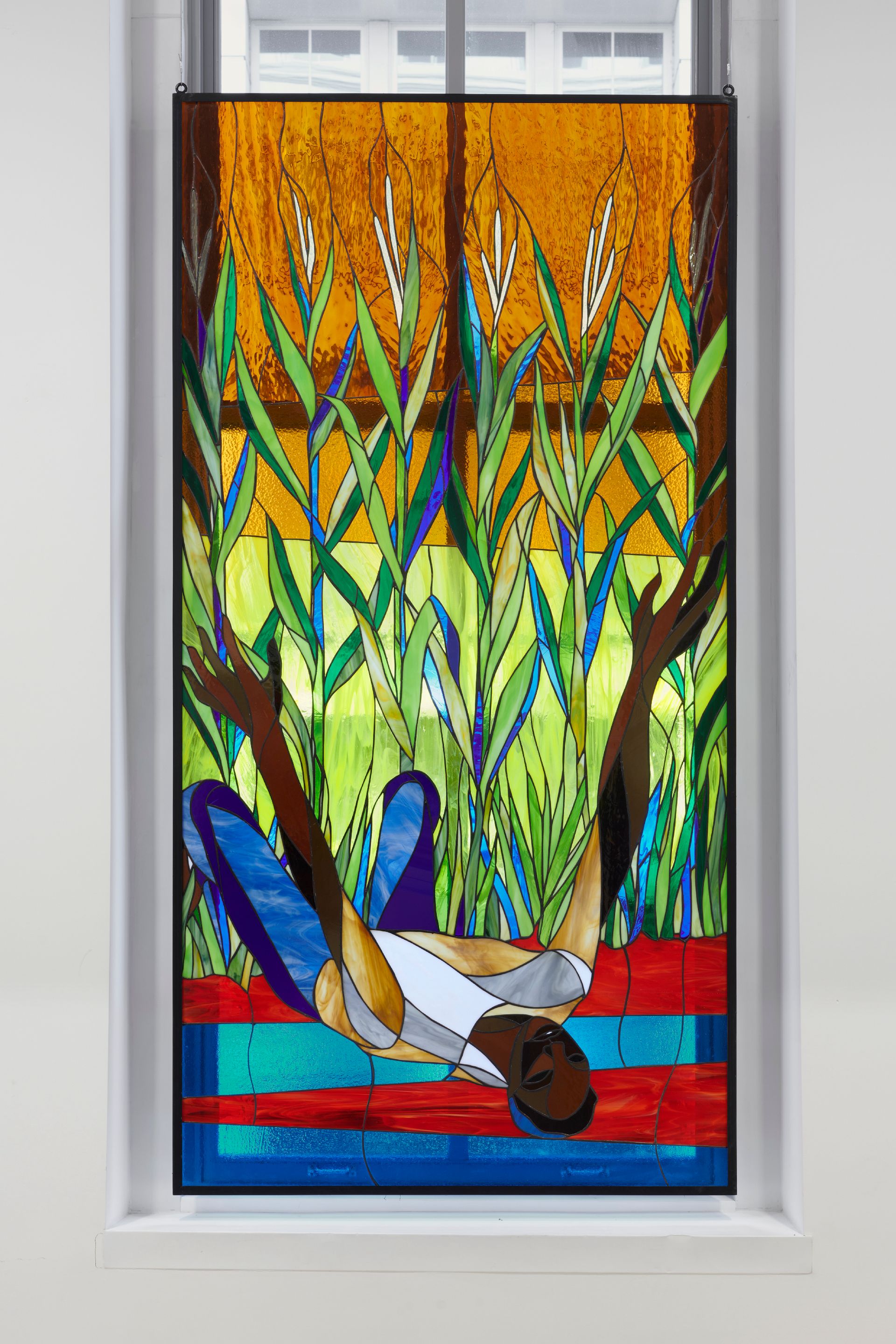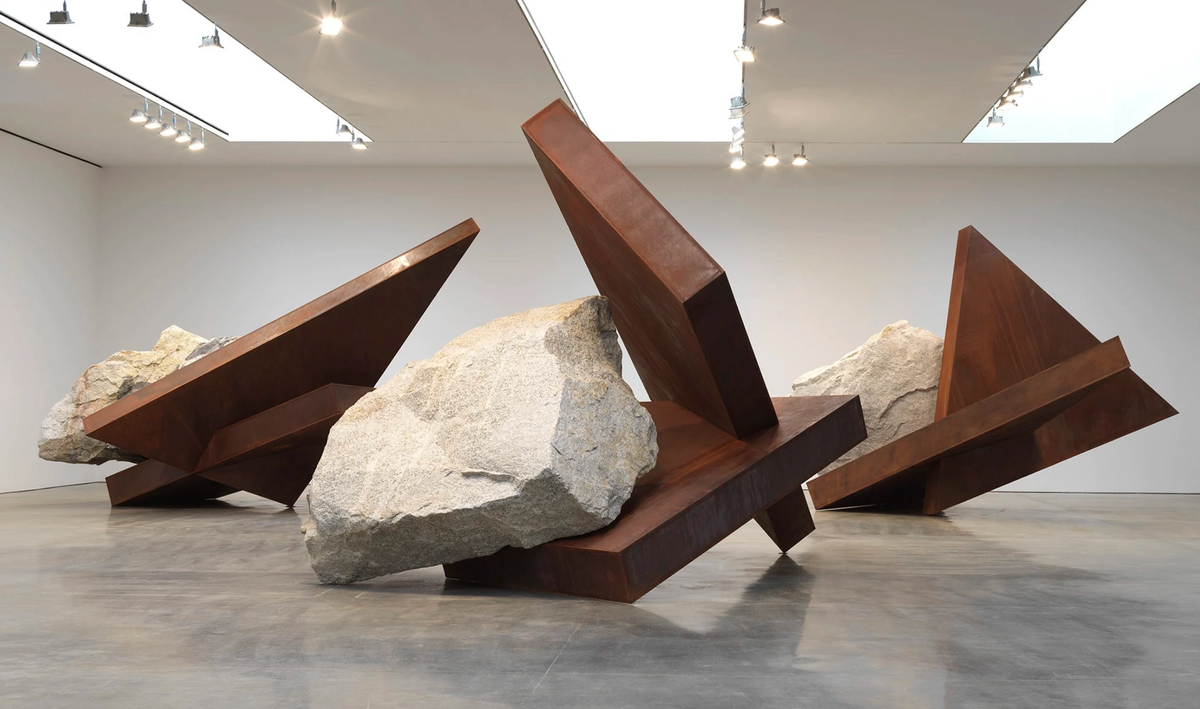Michael Heizer
Until 16 April at Gagosian, 522 West 21st Street, Manhattan
The unrivaled American artist Michael Heizer transcends the common categorisations of sculptor or conceptual artist. This exhibition, his first since Altars at Gagosian in 2015, presents a series of monumental sculptures made over the last four years that foreshadows the opening of his magnum opus City in the Nevada desert, which is due to open in a limited capacity this summer. In the series titled Rock/Steel (2017-ongoing) Heizer has mounted various stones extracted from a quarry in California, some weighing around 40 tons, on geometric cuts of A588 weathering steel (different from the Corten steel that Richard Serra uses in his work, the Gagosian director Kara Vander Weg notes). The juxtaposed geological and industrial materials create a negative sculpture, evoking historical works like Double Negative (1969) and Displaced/Replaced Mass (1969–77). Heizer’s practice primarily focuses on the magnitude of scale and emphasises an in-person experience. In his formative years, he was deeply influenced by his father, the anthropologist Robert F. Heizer, who wrote extensively on the spiritual and political symbolism of mammoth stones in ancient cultures; he also cites Gutzon Borglum, the artist who devised Mount Rushmore, as a great influence. The colossal sculptures “appear weightless and are like a magic trick, where there are invisible steel rods that go inside the rocks, and no visible welds on the outer edges of the sculptures”, Vander Weg says.
Frédéric Bruly Bouabré: World Unbound
Until 13 August at the Museum of Modern Art, 11 West 53rd Street, Manhattan
This career-spanning survey of the late prolific artist Frédéric Bruly Bouabré presents hundreds of small-scale drawings the artist devised as a hieroglyphic writing system honouring the linguistic and cosmological tradition of the Bété ethnic group of Côte d'Ivoire. The esoteric drawings range from vibrant stylised representations of humans and animals to ephemeral objects, creating a visual writing system that translates motifs into a coded panorama. The artist is said to have experienced a celestial vision in the late 1940s, a calling that he described in writing: “Since the sky opened to my eyes and the seven coloured suns described a circle of beauty around their Mother-Sun, I am the one that must from now on be called Cheik Nadro, the Revealer.” Ugochukwu-Smooth C. Nzewi, who curated the exhibition, says Bouabré, a self-taught artist, was unwavering in his commitment to condensing oral culture in an engaging visual form. The two separate series presented in the exhibition were donated by the art collector and photographer Jean Pigozzi, who gave MoMA more than 45 works of African contemporary art in 2019.

Christopher Myers, Nat Turner, 2022 Courtesy the artist and James Cohan, New York
Christopher Myers: The Hands of Strange Children
Until 2 April at James Cohan, 52 Walker Street, Manhattan
Light streams into James Cohan’s second-floor space through tall stalks of corn that loom over the prone figure of Nat Turner, the African American insurgent, in Christopher Myers’s striking stained glass work Nat Turner (2022). The scene is drawn from Turner’s confessions during the trial that ultimately resulted in his 1831 execution and depicts a moment of divine revelation in the young enslaved man’s life, which Myers renders in a composition inspired by Caravaggio’s The Conversion of Saint Paul (1600). It is emblematic of the works in The Hands of Strange Children, which focus on anti-colonialist figures, from the Paiute leader Wovoka to Maori prophet Te Ua Haumene. Myers depicts these leaders and the symbols associated with them in vibrant stained glass and riotously colourful appliqué textile tapestries, employing the iconography of spiritual art to meld historical scenes and mythological narratives. The rapturous results culminate in the 34ft-wide textile work Sarah Forbes Bonetta as Omoba Aina as Persephone (2021), a graphic narrative of Bonetta’s journey from her early life as a child slave in Dahomey to being given to a British captain as a diplomatic gift for Queen Victoria, who became her godmother. The vast tapestry records the powerful dislocations of Bonetta’s short life and the hybrid position she occupied. “Her place as an in-betweener, someone not fully home, neither here nor there, presages a lot of folks in the world subsequently,” Myers has said. “For all of the diaspora, globally, we live on the hyphen, like Sarah Forbes Bonetta, in the space between here and there.”


